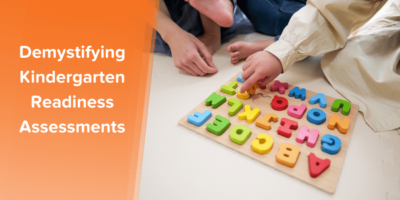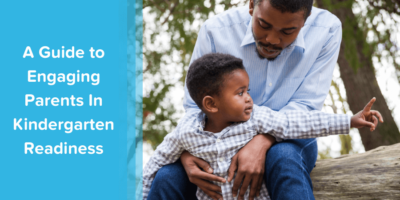By April Hawkins, marketing manager, and Françoise Lartigue, content manager
Last month, I left a demanding school leadership role to join ParentPowered. This was a hard decision that I made after realizing that my family life was happening without me. As you know, the pandemic had everyone working from home. In our house, this meant watching my wife and our toddler transition to bedtime while I continued to work. Month after month, my wish to spend more time with my family grew. Finally, the perfect opportunity came to positively impact kids while still spending time with my own family. You can imagine that I jumped in to this transition with both feet.
I was so ready for the transition that I didn’t even take a day off before starting my new role. I tested my computer and webcam setup several times to make sure I could connect to virtual meetings, and made a plan to be online an hour early. I was ready to be a supermom, too, and stocked the fridge with fresh veggies, fruits, and whole grains.

I told my wife not to worry about anything. From now on, I was going to pick Chloe up from school every day, take her to the park after school, make dinner, and do the bedtime routine.
The Trip to the Park
At the end of my first day in my new role, I headed off proudly to pick Chloe up from daycare and take her directly to the park. I brought snacks, a blanket, diapers, wipes – anything that might make this a well-planned experience. We arrived at the playground! And then, we just stared at each other. It was so awkward. I had no idea what to do with my 18 month old. She didn’t want to go on the slide or play on the swing set. She finally settled on picking up pebbles, and I quickly followed her lead, but she swatted the pebbles out of my hand and made it clear that I should not play. After watching her for a while, I finally just took her home.
That night, she screamed when I tried to put her to sleep. I finally handed her over, defeated, to my wife. Chloe snuggled into her shoulder and happily settled into the nightly routine of reading a book, taking a bottle, and going to sleep. I was embarrassed, confused, and honestly feeling a bit rejected.
Expert Help
The next day, I checked in with a colleague about what had happened. Luckily, I’m surrounded by early childhood experts. I was hesitant at first – would she think I’m an awful parent? Her response was so perfect, though. She reassured me that this is a transitional time, and toddlers need extra support when things change… even when it’s a positive change. She supplied me with some wonderful tips on engaging activities to do with my toddler, and a bunch of resources for navigating transitions. She also told me that I was doing a great job by simply following Chloe’s lead.
As I learned more about the transition process, I realized that I had not prepared my toddler for this big change. It turns out that Chloe was very used to my wife picking her up and bringing her home right after school. In one afternoon, I had completely derailed every one of Chloe’s routines. At the end of the day, my intention to start out with a bang was not allowing Chloe the time she needed to adjust to this major shift.
What’s Transition Time?
As parents, caregivers, and educators, we all prepare children for big and small transition times. A great example is the support we provide to students as they transition into Summer. We help kids transition in small ways too, from daytime to bedtime, and morning to school. The resources I found with ParentPowered to help ease my toddler’s transition time are very helpful for kids of all ages.
My colleague Françoise Lartigue joins me in this post to share expert tips on navigating transition times. Here are her words of wisdom:
1. Routines Rock
When kids know what to expect, it can make transition time easier for everyone. Building consistent routines around everyday transitions like getting ready for bed or cleaning up after playing can help young children better cope with shifting activities.
The best routines are the ones that are easy for parents and caregivers to stick to and kids can join in on. For example, after signaling it’s clean up time, using a silly clean up rhyme or song each time is a simple way to cue children to start the task.
Looking to make bedtime smoother? Try doing bath, books, bed every night in the same order. For more fun, try chanting it with your child, “Bath, Books, Bed! Bath, Books, Bed!” or asking, “We just had a bath! What comes next?”
In trying to navigate a shift to summer, build some new, simple and fun routines. When bigger transitions are happening at home, these same routines can also provide some much needed comfort and stability.
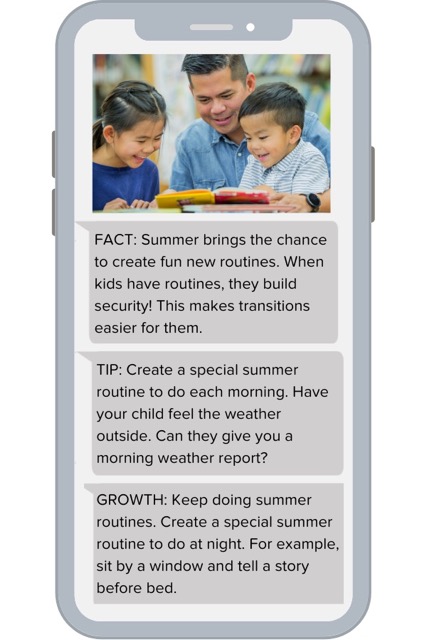
2. Transition Time Rituals and Signals
Having rituals or signals that can be used over and over to cue that a transition is happening is a simple way to support kids through the shift.
Going from home to school or child care can be the hardest part of the day for young children. Giving your child extra love and attention during goodbyes can make things easier. Create a short goodbye ritual that’s easy to repeat. It can help comfort your child.
Try something like always sharing a big hug and making a funny face before you go. A silly handshake or a certain number of kisses works too. For older kids, a silly saying or funny handshake can feel connecting.
Tell, Remind, Repeat...
The way we signal to children that something is about to happen and when it will happen can have a big impact on their willingness to join in. Transition signals in the form of verbal reminders can really help orient children to what is happening and what will happen next. The younger kids are the more transition signals they’ll need to shift activities.
Try spending a few minutes talking through what they are going to do before they do it. Use words like first, next and then. It might sound something like this: First, we get to play. Next, we’ll clean up our toys. Then, we’ll eat our snack!
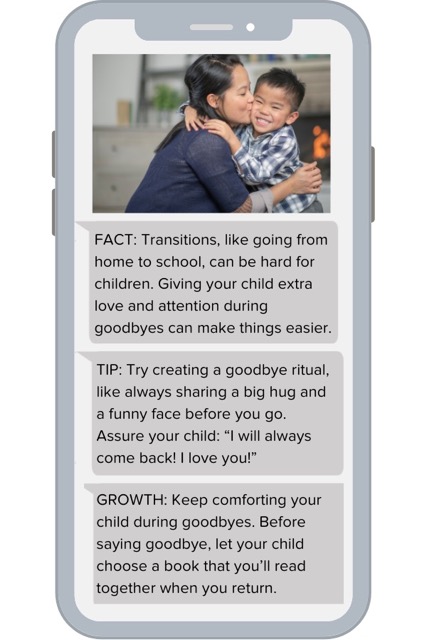
Time Transitions
For older children, using a timer can be a helpful transition time signal. Either setting it for the duration of the activity or for the last 5 minutes to signal clean up can go a long way in preventing arguments. Once children understand the concept of time, timers can offer a visual and auditory cue to shift to what’s next.
Getting kids to stop something fun and do something less desirable like getting ready for bed can feel like a huge task some nights. Providing a 5 minutes reminder: “In 5 minutes it’s time to get ready for bed. Then setting a timer: “When the timer goes off, you’ll need to stop what you’re doing to brush your teeth.
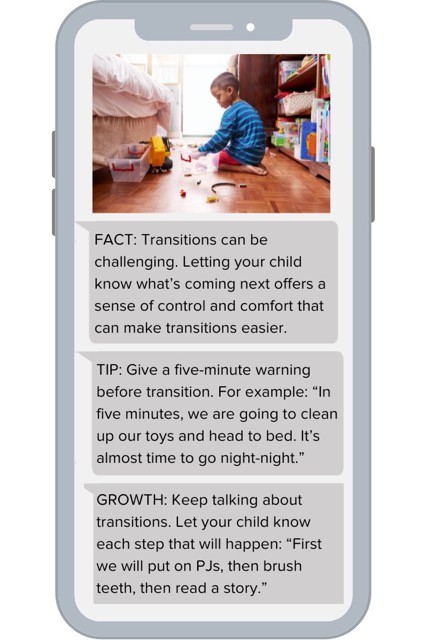
A favorite transition signal that works like a charm for all ages, is the “1 More”. When an activity is ending, check in and ask if there is “1 More” thing they would like to show, do, or tell you before moving on. They’ll understand that a transition is about to happen AND feel good about sharing that last important thing.
3. Feelings Matter
Whether it’s a young child feeling angry about having to clean up, an adult who is feeling overwhelmed about a new job, or anything in between – transitions can cause BIG FEELINGS. Sometimes, despite our best efforts and routines, transition time doesn’t go as planned. Being the parent or caregiver on the receiving end of these big feelings can be difficult and even make us feel angry.
It’s important to stay calm. When parents and caregivers have their own strategy for managing major meltdowns, it can help make the situation easier to navigate for everyone.
Check out this video clip from our most recent Family Fun Hour. Huffywumpus gets some big feelings about NOT wanting to clean up and Ms. Rebecca demonstrates some easy to use strategies for keeping calm and coping.
Taking a moment to honor your feelings is a good first step to navigating bigger transitions. Using the strategy of sparking strength by pausing to notice. It can help you feel empowered and ready to take things on.
These days, it’s not just kids who are experiencing a lot of transitions, both big and small. Many adults are too. We are all transitioning to a post-pandemic life that can be both exciting and anxiety producing.
Taking a moment to honor your feelings is a good first step to navigating bigger transitions. Using the strategy of sparking strength by pausing to notice. It can help you feel empowered and ready to take things on.
4. Transitions Take Time
And no matter how strong you are, transitions take time. This is true for young kids learning to move to the next activity or adjusting to a new routine. It can take time to adjust to the ending of a school year or the beginning of a new job. We can expect bumps in the road, even if the transition is exciting and positive. Allowing yourself or a child the space to work through emotions is key to navigating through transitions big or small. April discovered that time is a game changer!
ParentPowered Tips for Transition Time Are Game Changers
The ParentPowered tips Françoise shared above were hugely beneficial in my family. The most impactful was simply honoring the time that it takes to transition. Giving our toddler time to adjust to our new routines has been a game changer. It turns out that all I had to do was take a step back and let Chloe keep some of her old routines. This gave her time to adjust to new ones.
It’s been six weeks, and Chloe’s comfort with me has grown immensely. We dance and make music together. At the end of the day, she snuggles into my arms and lets me read to her. We still experience bumps in the road, and sometimes she just wants to be with my wife. As we navigate this, I will continue to be patient, and know that these things take time.






